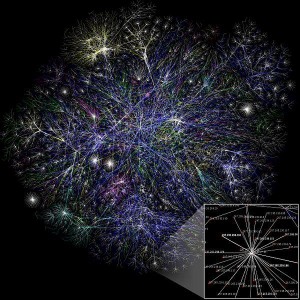Gossip, Graphs and Guerrilla Marketing no comments
Why would Web Scientists be interested in Gossip?
Gossip is defined as “idle talk; trifling or groundless rumour” between people and is usually thought of as being rather innocuous and of little consequence (OED 2013). The Web facilitates the free exchange of information regardless of quality or authenticity and this could be useful or contentious when mining the Web for data.
Gossip is a form of information exchange but unlike scholarly communication or financial transactions it is rarely coherent, uniform or predictable. The prolific use of the Web 2.0 in particular the social networking sites and micro-blogs allows gossip to spread between platforms and in different forms. A mosaic of verbal and pictorial information and more importantly combinations of the two spread throughout the Web.
Ultimately, gossip is a way of exchanging information in an informal and relaxed manner. Before Web scientists attempt to design or engineer new web technologies they must understand what the Web is being used for currently. This is of great use to Web scientists because it can help them understand how information can be exchanged faster and easier and how their efforts can facilitate this exchange.
The reader may feel that this review is nothing but mere folly and they could be forgiven for thinking that. However, the author would ask them to consider how the principles of gossip could be applied to more serious and practical fields e.g. disaster relief, management, law enforcement. Gossip transcends technical and social boundaries and so it will be of use when studying the Web as a socio-technical object.
Why Network Science?
Network science offers a near perfect set of techniques and practices for studying the Web. Due to the mixed lineage of this field it offers a variety perspectives of networks as social and technical entities. Biological networks are of interest as well – the study of other species such as cephlapods or bees could inform Web science about information exchange.
Network science leans upon sub-fields that have themselves been created from interactions by other disciplines e.g. graph theory (mathematics, computer science) and social network analysis (sociology and anthropology). This chimera of a discipline allows for the topic to be fully opened up and examined thoroughly by illustrating its interconnected nature.
Newman, Barabasi and Watts (2006:4) provide clear cut guidance as to why their discipline is different.
- It is focused on “real-world problems” and is willing to sacrifice theoretical purity for real world application.
- It views networks as dynamic entities and will not settle for static models.
- It aims to “understand the framework on which distributed dynamical systems are built”.
- It explains rather than describes networks and uses stochastic processes to understand the changes in networks.
It will provide a stimulating read to say the least and offers insights previously hidden in the fragments of other disciplines.
Why Marketing?
“The aim of marketing is to make selling unnecessary” Drucker (2001:20).
If gossip is the idle talk amongst people, marketing is the attempt to infiltrate this “idle talk” and make it into a profitable opportunity. Marketing provides a perspective borne out of commerce and academia and offers insight into how information exchange is made into a commercial product.
Marketing is made up of segments and channels. The segments are different markets and the potential consumers within them. The channels are the method by which a marketer will reach them and build a relationship with so as to continually acquire their custom. From humble posters in shop windows to multi-millionaire pound advertising campaigns, marketing is essentially about raising awareness through word of mouth. Marketers make use of traditional (offline) and digital methods and this means that the Web is of great importance to them.
Marketing provides a mixture of theatre and statistics. It has an array of metrics to measure the success of a commercial activity which can give marketing near-science like properties. It is heavily influenced by economics, business studies, psychology and computer science. Especially the statistical techniques and numeric concepts within these disciplines and how they can aid decision making. However, it also attempts to allure customers not through technical or economic measures but through appealing to consumer’s subconscious desires. For a campaign to be successful it must use art and design, music and even activism.
It will provide an opportunity to see how the Web is used to generate custom and subsequent profits. This demonstrates that gossip is used not just as a social mechanism but also as a commercial one.
Convergence of the two disciplines?
The emphasis on analysing social networks is an obvious property of both disciplines. It is not clear as to whether marketers have the capital (human, cultural, financial, physical) to utilise the same tools as network scientists. It may be the case that they can collaborate and share access to data and any insights gleaned from it. The interest in real-world social networks and observing them in real time is something that will be of use to Web scientists and will further extend their influence to other small-world networks.
P.S. This post was originally posted on 15/10/2013 – however, it failed to publish and only showed the title. The author apologises unreservedly for any technical blunders on their part.
